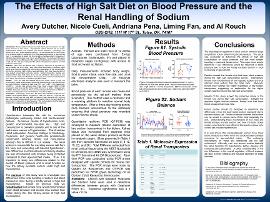| dc.contributor.author | Dutcher, Avery | |
| dc.contributor.author | Fan, Liming | |
| dc.contributor.author | Rouch, Al | |
| dc.date.accessioned | 2023-09-12T16:44:50Z | |
| dc.date.available | 2023-09-12T16:44:50Z | |
| dc.date.issued | 2022-02-18 | |
| dc.identifier | ouhd_Dutcher_effectsofhighsaltdieton_2022 | |
| dc.identifier.citation | Dutcher, A., Fan, L., & Rouch, A. (2022, February 18). The effects of high salt diet on blood pressure and the renal handling of sodium. Poster presented at Research Days at Oklahoma State University Center for Health Sciences, Tulsa, Ok. | |
| dc.identifier.uri | https://hdl.handle.net/11244/339513 | |
| dc.description.abstract | Introduction: The association between elevated dietary salt consumption and high blood pressure is well known. Hypertension carries elevated risk for stroke, cardiovascular disease, liver disease, and nervous disorders. Interestingly, sex differences in many areas of pathophysiology. Pre-menopausal women have shown to be protected against hypertension and renal diseases compared to age matched men. It is reasonable to expect that how the kidney handles sodium in presence of high-salt consumption plays a key role in sex differences. The purpose of this study was to determine sex differences in the renal handling of sodium in mice consuming a high-salt diet. We also investigated the effects of high-salt consumption on blood pressure in these mice. | |
| dc.description.abstract | Methods: Intact male and female mice (n=6/group) consumed a high-salt (4%, HarlanTeklad) diet for 30 days. Mice were placed individually in metabolic cages where urine could be collected for volume and measurement of Na+ concentration. Urinary Na+ excretion (NAE, mg/day) was determined from daily measurements of urine sodium concentration and urine volume. Sodium intake (Nai, mg/day) was determined from daily food intake of 4% salt diet ad libitum. Blood pressure was measured daily via the tail-cuff method. Expression of key sodium transport proteins in the kidney was measured via real-time quantitative PCR. | |
| dc.description.abstract | Results: From the data accumulated during the 30-day period of high salt consumption, female mice showed a significantly lower average of the output-to-input Na+ ratio (NAE/Nai) compared to male mice (53.3 ± 2.7 vs 68.1 ± 1.8, respectively, p<0.0001). Female mice showed lower mean blood pressure (MBP, mmHg) compared to male mice over the 30-day period (78.4 ± 1.0 vs 84.9 ± 1.2 respectively, <0.0005). Molecular expression of the key sodium transporter Na+ -2Cl- -K + (NKCC) in the thick ascending limb was over 5-fold higher in the female kidney. | |
| dc.description.abstract | Conclusion: Interestingly, results from this study demonstrated that female mice retained more ingested sodium compared to male mice while on a high-salt diet. Moreover, female mice had lower MBP compared to male mice while on a high-salt diet. We suspect that sex steroids are playing important roles in the renal handling of sodium and in the control of blood pressure. This study suggests that females are protected from deleterious effects of high-salt consumption. | |
| dc.format | application/pdf | |
| dc.language | en_US | |
| dc.publisher | Oklahoma State University Center for Health Sciences | |
| dc.rights | The author(s) retain the copyright or have the right to deposit the item giving the Oklahoma State University Library a limited, non-exclusive right to share this material in its institutional repository. Contact Digital Resources and Discovery Services at lib-dls@okstate.edu or 405-744-9161 for the permission policy on the use, reproduction or distribution of this material. | |
| dc.title | Effects of high salt diet on blood pressure and the renal handling of sodium | |
| osu.filename | ouhd_Dutcher_effectsofhighsaltdieton_2022.pdf | |
| dc.type.genre | Presentation | |
| dc.type.material | Text | |
| dc.subject.keywords | salt | |
| dc.subject.keywords | blood pressure | |
| dc.subject.keywords | sex differences | |
